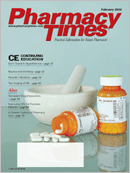Publication
Article
Pharmacy Times
A Look at Diabetic Retinopathy
Author(s):
Diabetic retinopathy (DR) is aleading cause of blindness andloss of vision in adults <60years of age. Studies estimate that,among the 10.2 million adults with diabetes,40.3% have diabetic retinopathy.Sight-threatening retinopathy is presentin 8.2% of that group.1 Retinopathyis the most common microvascularcomplication of diabetes and results inblindness for >10,000 individuals peryear.2 This complication has devastatingeffects from personal and societalperspectives. Patients with DR havesignificant qualitative and quantitativedecreases in health-related quality oflife.1 Treatment options are limited andmarginally effective.
Evidence suggests that ocular damagefrom chronically elevated blood glucosemay begin as early as 7 years prior to theclinical diagnosis of type 2 diabetes.3Mechanisms leading to eye damageinclude polyol accumulation, which leadsto high sorbitol concentrations in cells;formation of advanced glycation endproducts (AGEs); oxidative damage; andactivation of protein kinase C (PKC).Activation of these pathways results inthickening of basement membranes, pericyteloss, and microaneurysm formation.
DR is a progressive condition thathas 3 different stages: (1) no apparentDR; (2) nonproliferative DR; and (3) proliferativeDR (PDR). Nonproliferative DRis characterized by dilation of veins inthe eye, microaneurysms, retinal hemorrhages,and retinal edema hard exudates.4 In PDR, abnormal blood vesselsbegin to grow on the retina. These vesselscan begin to leak, resulting insevere damage. At any stage in thisprogression, fluid can leak into themacula, causing blurred vision. Thiscondition is known as diabetic macularedema (DME) and is one of the mostcommon causes of vision loss in peoplewith diabetes.
A number of techniques are availableto make the diagnosis of DR, but ophthalmoscopyis used most commonly tomonitor for DR. Regular dilated eyeexaminations can help prevent blindnessand are a cost-effective approach todetecting DR. Annual examinations arerecommended by the American DiabetesAssociation.5,6 The frequency of screeningis controversial in low-risk patients,and some researchers have suggestedthat less frequent screening may beappropriate if a mechanism exists to preventpatient loss to follow-up.5
Currently, the most effective methodof slowing progression of DR is glycemiccontrol. The relationship between glucosecontrol and retinopathy has beenwell-described in previous studies.7,8Control of other comorbid conditionsalso has been shown to help delay progressionof DR. Increased diastolic bloodpressure has been associated with ahigher incidence of macular edema, andintensive blood pressure control hasbeen shown to delay progression ofDR.9,10 Management of impaired renalfunction and serum lipid levels also hasbeen shown to delay progression of DR.4
Limited treatment options are availablefor the treatment of sight-threateningDR. Laser photocoagulation hasbeen shown to be effective in reducingthe progression of DR, and vitrectomycan prevent severe vision loss inpatients who are in advanced stages ofDR. Both treatments may result in additionalvision loss, however, and neithercan reverse losses of vision that havealready occurred.
A number of pharmacotherapeuticoptions have been or are currently understudy for DR. Researchers are focusingon inhibiting each of the mechanisms ofDR progression: accumulation of sorbitol,production of AGEs, increased oxidativestress, and activation of the PKC-βpathway.The most promising agents thus farappear to be those that block the PKC-β‚pathway.4 Ruboxistaurin, an experimentalinhibitor of the PKC pathway, hasbeen shown to prevent and reverse themicrovascular complications of diabetes,to prevent growth of new blood vesselson the retina, and to inhibit the effects ofvascular endothelial growth factor(VEGF).
Medications that are currently availablealso have been studied.4 Aldosereductase inhibitors have been testedfor their ability to reduce sorbitol accumulation,but they have not beenproven to be of benefit. Antioxidantssuch as tocopherol have been studied,with conflicting results. High-doseaspirin (650 mg/day) may be beneficialas prophylaxis in the early stages ofDME and DR, but the benefit does notappear to extend into later stages of thedisease. Angiotensin-converting enzymeinhibitors and angiotensin IIreceptor antagonists decrease retinalVEGF expression. Further study is neededto determine whether the benefits ofthese medications are independent oftheir hypotensive properties.
Diabetic retinopathy is a potentiallydevastating microvascular complicationof poorly controlled diabetes. Preventionof the disease by modifying underlyingrisk factors is the cornerstone of treatment.Options are limited and carry therisk of worsening vision. A number ofpharmacologic treatments are currentlyunder study and may prevent or reversevisual loss. Pharmacists can play a significantrole in helping people to be bettermanagers of their disease, thereby preventinglong-term complications that canhave a devastating effect on their lives.
Dr. Garrett is a clinical pharmacistpractitioner at Cornerstone HealthCare in High Point, NC.
For a list of references, send astamped, self-addressed envelope to:References Department, Attn. A. Stahl,Pharmacy Times, 241 Forsgate Drive,Jamesburg, NJ 08831; or send an e-mailrequest to: astahl@ascendmedia.com.







